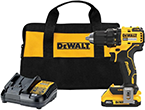Using a Power Cleaner on Your Walls
Written by Lee Wyatt (last updated June 10, 2019)
Using a power cleaner on your walls can be one of the easiest, quickest, and most efficient ways around to ensure that you get your walls clean. However, if you aren't careful then you can end up damaging those very same walls. To avoid that problem all you need to do is ensure that you keep these guidelines in mind.
- Cleaning inside or out? Power cleaners can be used to help clean your walls, both inside and outside. The thing is that you will need to take additional steps to help protect your floors if you are cleaning inside walls. Basically it doesn't hurt to move all your furniture to the middle of the room, and lay down some drop cloths along the walls to help protect the floors.
- Remove loose dirt. Use a soft bristled broom or even a feather duster to remove as much of the loose dirt, dust, and grime as possible. Ensure that you have the drop cloths down on the ground to help ensure that you can limit the mess. If you are cleaning exterior walls you can let the dirt and grime simply fall to the ground.
- Vacuum. Once you have gone over the walls with your broom or feather duster go over the wall again with a vacuum cleaner. This will get any remaining dirt, dust, or grime that you may have missed earlier. Just make sure that you when you do this you have the soft bristled attachment on the vacuum to help get into all the nooks and crannies that can be found on your walls.
- Hook up the cleaner. Familiarize yourself with the operating instructions of your cleaner, and hook it up appropriately. Even if you have used the cleaner before, by following this pattern you can avoid using the cleaner in the wrong way, while also ensuring that everything is in good working order.
- Choose the appropriate settings. Most power cleaners have at least two settings, and you need to make sure that you have the appropriate settings chosen for your project. For example, if you are cleaning inside you will want to choose the steam cleaner method, whereas the setting for the exterior is more power than steam. The exterior setting is a bit more messy and wet that the one for the interior, so make sure that you choose the right setting or you can make a huge mess.
- Start at one end. When you do start cleaning your walls start your work at one end of the wall near the ceiling, and work your way across and down. This will ensure that you limit the crossover from the dirt, and that you cover the entire wall.
Once you have finished washing the walls, you really only need to let the walls dry. Ideally you will want to let the walls air dry as it will allow you to avoid inadvertently damaging any paint that you may have on the walls. If you are working on interior walls, simply open the windows and allow time to pass. However, if you need to hurry things up you can pat dry the walls if you are careful.
Author Bio
Lee Wyatt
Contributor of numerous Tips.Net articles, Lee Wyatt is quickly becoming a regular "Jack of all trades." He is currently an independent contractor specializing in writing and editing. Contact him today for all of your writing and editing needs! Click here to contact. Learn more about Lee...
Organizing a Business
If you are thinking of starting your own business then you need to be aware that you are going to be in for a long and ...
Discover More
Removing the Odor of Sickness
Anyone that has ever been around chronically sick, or terminally ill people know how there is a slight, but significant, ...
Discover More
How to Replace Struts
Next to a shock absorber, one of the more common parts that need to be replaced on your vehicle is the struts. While you ...
Discover More
More Home Improvement Tips
Finishing Drywall
Just because you have hung your drywall doesn't mean that you are finished. Finishing drywall is a completely different ...
Discover More
Repairing Cracks in Plaster Walls
While plaster may be a very popular building material, it is also somewhat susceptible to cracks. If you don't take the ...
Discover More
Repairing Masonry Walls
Even the most well-made and properly maintained masonry wall will eventually need a repair or two. If the problem isn't ...
Discover More

Comments